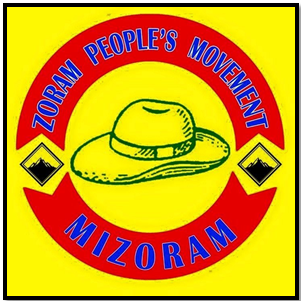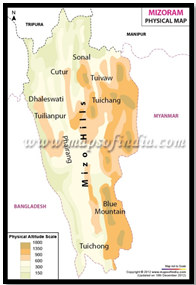AN EXPERIMENTAL POLITICAL CHOICE BY THE MIZO ELECTORATE
Relevance:
GS 2 and 3
- Functions and responsibilities of the Union and the States, issues and challenges pertaining to the federal structure, devolution of powers and finances up to local levels and challenges therein.
Why in News:
- In recent Mizoram elections, Zoram People’s Movement (ZPM) emerges as victorious.
Source- The Telegraph
The 2023 Mizoram Assembly election marks a significant departure from traditional political trends, with the Zoram People’s Movement (ZPM) securing a decisive victory. This shift underscores a changing preference for regionalist parties.
Contextual Overview
- The recent Mizoram Assembly election illustrates both continuity and change in the state’s electoral landscape.
- The election upheld the trend of alternating parties in power since 1987, with the Zoram People’s Movement (ZPM) winning convincingly after the Mizo National Front’s (MNF) term.
Shift in Electoral Dynamics
- Unlike prior contests between national and regional parties, this election mainly featured a rivalry between two regionalist parties: ZPM and MNF.
- The Congress, traditionally influential, dwindled to insignificance, but its maintained vote share hints at future possibilities in the dual-party system.
- Mizoram’s usual trend of aligning with the party in power at the Centre for financial support was challenged by the ZPM’s victory, indicating an experimental choice by Mizo voters.
Emergence and Ascension of ZPM
Source- Nagaland Tribunes
Formation and Rapid Growth
- Zoram People’s Movement (ZPM) surfaced as a regionalist party in 2017.
- Despite being newly established, within four years, it showcased substantial progress in the 2023 Mizoram Assembly elections.
- Its impressive rise from eight seats and a 22% vote share in 2018 to 27 seats and over 37% vote share in 2023 reflects a significant shift in electoral support.
- Strategic Candidate Selection
- ZPM strategically fielded a mix of candidates with varied backgrounds.
- Notable personalities like Lalduhoma, a former Indian Police Service officer with political connections, national football player Jeje Lalpekhlua, and other influential figures contributed to the party’s appeal.
- Alignment with Local Issues and Aspirations
- ZPM leveraged regional sentiments and aspirations effectively, emphasizing its commitment to promoting Zo nationalist causes.
- By aligning these aspirations with governance reform and development agendas, it resonated deeply with the electorate.
Winning Factors for ZPM
- ZPM aligned its vision with Zo nationalist aspirations, emphasizing governance reforms and development initiatives.
- Promises like minimum support prices for rural cash crops gained traction amid the majority dependent on agriculture.
- ZPM strategically positioned itself as an alternative to MNF, emphasizing efficient and corruption-free governance.
- The party fielded a diverse set of candidates, leveraging their backgrounds to connect with the electorate.
Implications and Future Scenarios
- While ZPM’s victory marks a shift, MNF’s continued substantial support indicates a dynamic electoral landscape.
- Revival strategies for Congress and MNF, beyond their current leadership, will likely shape future elections.
- The effectiveness of the incumbent Chief Minister Lalduhoma in steering Mizoram, possibly through aligning with BJP, remains uncertain and subject to future developments.
Dynamics of Electoral Behavior
Shift in Voter Preferences
- The Mizoram electorate historically showcased a trend of alternating parties in power, but the 2023 election presented a significant departure.
- Traditional support bases, particularly for the Congress, witnessed a decline, opening a vacuum that ZPM capitalized on.
- Anti-Incumbency and Dissatisfaction
- The defeat of the Mizo National Front (MNF) after a term in power indicates prevailing anti-incumbency sentiments.
- The electorate’s dissatisfaction with the previous ruling party and a hunger for change propelled ZPM’s ascent. Policy Promises and Socio-Economic Relevance
- ZPM’s pledges, such as minimum support prices for rural cash crops, struck a chord in a state where a majority relies on agriculture.
- They effectively addressed the ongoing socio-economic challenges, resonating strongly among the populace.
Critique of Existing Alliances and Issues
- ZPM capitalized on criticizing MNF’s affiliations, particularly its alliance with the Bharatiya Janata Party (BJP).
- Highlighting alleged failures in protecting minority groups further contributed to ZPM’s electoral gains.
Congress’ Waning Influence
- The decline of the Congress, a historically dominant force in Mizoram politics, created an opening that ZPM adeptly utilized.
- The diminishing appeal of established leaders within the Congress significantly contributed to this electoral shift.
The Zoram People’s Movement’s triumph signifies a distinct shift in Mizoram’s political landscape, emphasizing the rise of regionalist forces while challenging established party dynamics. Yet, the continued support for traditional parties suggests an ongoing evolution, urging the need for adaptive strategies and fresh leadership to navigate Mizoram’s political future effectively.
Mizoram
Historical Background: · Mizo Hills area: Lushai Hills district within Assam post-independence; renamed Mizo Hills District of Assam in 1954. · Mizoram’s progression: Union Territory status in 1972 after an accord with MNF moderates; full statehood in 1986 via Mizoram Peace Accord. Geographical Location: · Borders: Myanmar and Bangladesh (International); Tripura, Assam, and Manipur (State). Demography: · Population: Approx. 1.27 million, second least populous after Sikkim. · Sex Ratio: 975 females per 1000 males (National: 943). · Literacy Rate: 91.58% (National: 74.04%). Biodiversity: · Forest Cover: Highest in NE India at 84.53% of own geographical area (as per ISFR 2021). · State Animal: Saza (serow); State Bird: Vavu (Hume Bartailed Pheasant). Protected Areas: · Dampa Tiger Reserve, Murlen National Park, Phawngpui National Park, Ngengpui Wildlife Sanctuary, Tawi Wildlife Sanctuary. Tribals: · Highest tribal population concentration among Indian states. · Mizos consist of 5 major and 11 minor tribes (Awzia) – Lushei, Ralte, Hmar, Paihte, and Pawi. · Close-knit society without class, sex, status, or religious discrimination. · Primarily agriculturists practicing “Jhum Cultivation” or slash-and-burn cultivation. Festivals and Dance: · Festivals: Mim Kut (Maize festival in August-September) and Chapchar Kut (Spring Festival). · Cheraw: Traditional and colorful dance using long bamboo staves, often termed ‘Bamboo Dance’. |
Source:
The Hindu
Mains Question:
Analyze the dynamics of rise of Zoram People’s Movement (ZPM). Discuss the factors contributing to the electoral shift and electoral behavior.

 Source- Nagaland Tribunes
Source- Nagaland Tribunes Source- India Maps
Source- India Maps

